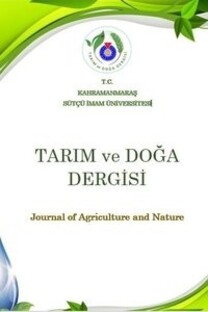The Effect of Cuttings Stages on Components and Content of Essential Oils from Salvia viridis L.
Salvia viridis L.’den Elde Edilen Uçucu Yağın Miktarı ve Bileşenleri Üzerine Biçim Zamanlarının Etkisi
___
Abdallah M, Abu-Dahab R, Afifi F 2013. Composition of the Essential Oils from Salvia L. and Salvia hormium L. Grown in Jordan. Jordan Journal of Pharmaceutical Science, 6: 40-47.Acıkgoz N, Ilker E, Gokcol A 2010. Biyolojik Araştırmaların Bilgisayarda Degerlendirilmeleri, Ege Üniversitesi, E.Ü. Totem, Yayın No:2, İzmir,48-56s.
Amiri H 2007. Quantative and Qualative Changes of Essential oil Salvia bracteata Bank et Sol. in Different Growth Stages. DARU Journal of Pharmaceutical Sciences, 15:79-82.
Baytop T 1984. Therapy with Medicinal Plants in Turkey (past and present). Istanbul University, Publication No:3255/40, Istanbul, p. 166 (In Turkish).
Bown D 2002. The Royal Horticultural Society New Encyclopedia of Herbs & Their Uses. Great Britan, A Penguin Company, pp.353-356.
Davis PH 1982. Flora of Turkey and the East Aegean Islands. Edinburg University, Edinburg, Vol. 7,pp.400-446.
Demirci B, Tabanca N, Baser, KHC 2002. Enantiomeric Distribution of Some Monoterpenes in The Essential Oils of Some Salvia Species. Flavour and Fragrance Journal, 17:54-58.
Dweck AC 2000. Sage, The Genus Salvia Ed. Kintziou SE. The Netherlands, Harwood Academic Publishers,1-25.
Kahriman N, Cansu TB, Yilmaz N, Yasar A, Cetin MM, Yayli N 2010. Constituents of The Essential Oil from The Flower, Leaf and Stem of Salvia viridis L. Grown in Turkey. Asian Journal of Chemistry, 22: 3439-3446.
Kokkalou PE, Koedam A, Fokas G 1982. Composition de l’huile essentielle de Salvia horminum (Labiatae). Pharmaceutica Acta Helvetiae, 57: 317- 320.
Kuwahata H, Katsuyama S, Komatsu T, Nakamura H, Corasaniti MT, Bagetta G, Sakurada S, Sakurada T 2012. Local Peripheral Effects of βcaryophyllene through CB2 Receptors in Neuropathic Pain in Mice. Pharmacology& Pharmacy, 3: 397-403.
Lakušić BS, Ristić MS, Slavkovska VN, Lj Stojanović D, Lakušić DV 2013. Variations in Essential Oil Yields and Compositions of Salvia officinalis (Lamiaceae) at Different Developmental Stages. Botanica SERBICA, 37: 127-139.
Lattoo SK, Dhar RS, Dhar AK, Sharma PR, Shri G, Agarwal SG 2006. Dynamics of Essential Oil Biosynthesis in Relation to Inflorescence and Glandular Ontogeny in Salvia sclarea. Flavour and Fragrance Journal, 21:817-821.
Mirjalili MH, Salehi P, Sonboli A,Vala MM 2006. Essential Oil Variation of Salvia officinalis Aerial Parts During its Phonological Cycle. Chemistry of Natural Compounds, 42: 19-23.
Müller-Riebau FJ, Berger BM, Yegen O, Cakir C 1997. Seasonal Variations in The Chemical Compositions of Essential Oils of Selected Aromatic Plants Growing Wild in Turkey. Journal of Agriculture and Food Chemistry, 45:4821-4825.
Nandi N 2012. Chirality in Biological Nanospaces: Reactions in Active Sites, Taylor and Francis Group, CRC Press, pp. 123-125.
Ozdemir C, Baran P, Aktas K 2009. Anatomical Studies in Salvia viridis L. (Lamiaceae). Bangladesh Journal of Plant Taxonomy, 16: 65-71.
Ozek T, Tabanca N, Demirci F, Wedge DE, Baser KHC 2010. Enantiomeric Distribution of Some Linalool Containing Essential Oils and Their Biological Activities. Records of Natural Products, 4:180-192.
Pitarevic I, Kuftinec J, Blazevic N, Kustrak D 1984. Seasonal Variation of Essential Oil Yield and Composition of Dalmatian sage, Salvia officinalis. Journal of Natural Products, 47: 409-412.
Pogroszewska E, Laskowska AH 2008. The Influence of Cultivation Method on the Flowering of Salvia horminum L. ‘Oxford Blue’. Acta Agrobotanica, 61:159-166.
Rayouf MBT, Msaada K, Hosni K, Marzouk B 2013. Essential Oil Constituents of Salvia argentea L. from Tunisia: Phenological Variations. Medicinal and Aromatic Plant Science and Biotechnology, 7: 40-44.
Ucar S. 2014. Salvia species effects on Alzheimer disease. University of Erciyes, Faculty of Pharmacy, Graduation Project, pp.65.
Yang D, Michel L, Chaumont JP, Millet-Clerc J 1999. Use of Caryophyllene Oxide as an Antifungal Agent in an in Vitro Experimental Model of Onychomycosis. Mycopathologia, 148:79-82.
Yayli N, Cansu TB, Yilmaz N, Yasar A, Cetin MM, Yayli N 2010. Constituents of The Essential Oil from The Flower, Leaf and Stem of Salvia viridis L. Grown in Turkey. Asian Journal of Chemistry, 22:3439-3446.
Zawiślak G 2013. The Chemical Composition of Essential Hyssop Oil Depending on Plant Growth Stage. Acta Scientiarum Polonorum Hortorum Cultus, 12:161-170.
- ISSN: 2619-9149
- Yayın Aralığı: Yılda 6 Sayı
- Başlangıç: 2018
Van Florasında Yayılış Gösteren Teucrium Cinsine Ait Bazı Türlerin Kimyasal İçerikleri
Alya KARA, Murat TUNÇTÜRK, Tamer ERYİĞİT
Aftab JAMAL, Waqar YOUNAS, Muhammad FAWAD
Adem ÖZARSLANDAN, Dilek DİNÇER, Refik BOZBUĞA
Karyological Studies on Nine Astragalus L. Taxa in Turkey
OSMAN GEDİK, Murat KURŞAT, YAŞAR KIRAN
Türkiye’de Domates Üretimi, Dış Ticareti ve Rekabet Gücü
Su ve Arazi Tabanlı Rekreasyon Olanaklarının Belirlenmesi: Ankara Güneyi Alt Havzası Örneği
Emel BAYLAN, Zuhal DİLAVER, Ayşe DEMİR, Ekin OKTAY
Aspir (Carthamus tinctorius L.) Genotiplerinin Fiziksel ve Kimyasal Özelliklerinin Belirlenmesi
Mehmet KOBUK, Kamil EKİNCİ, SABRİ ERBAŞ
Adana İli Tufanbeyli İlçesi Meralarının Vejetasyon Yapısı Üzerine Bir Araştırma
Selahattin ÇINAR, RÜŞTÜ HATİPOĞLU, Sait AYKANAT, Celal YÜCEL, İlker İNAL
